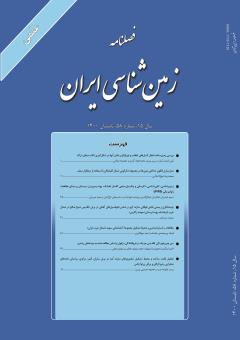مدل¬سازی الگوی تداخلی چین¬ها¬ در مجموعه دگرگونی شمال گلپایگان با استفاده از نرمافزار متلب
محورهای موضوعی :
1 - سازمان زمینشناسی و اکتشافات معدنی کشور
کلید واژه: الگوی تداخلی# چین# گلپایگان# مدل¬سازی# نرمافزار متلب#,
چکیده مقاله :
مدل سازی ساختارهای زمین شناسی نقش مهمی در شناخت هندسه ساختارها و نیز درک روابط ساختارها با یکدیگر دارد. در سال های اخیر مدل سازی رقومی با استفاده از رایانه مورد اقبال و توجه مهندسان و پژوهشگران علوم پایه قرار گرفته است. "متلب" یکی از نرمافزارهایی است که با امکانات گسترده خود برای تجزیه و تحلیل داده ها و مدل سازی در علوم مختلف از جمله زمین شناسی ساختاری مورد استفاده قرار می گیرد. در این نوشتار مدل های ممکن از الگوهای تداخلی سه نسل چینخوردگی در سنگ های دگرگون ناحیه گلپایگان با استفاده از کد نوشته شده در نرم افزار متلب بازسازی شده اند. داده های مورد نیاز برای مدل سازی الگوهای تداخلی شامل وضعیت محور چین میانگین و صفحه های محوری میانگین مربوط به سه نسل پیاپی از چینخوردگی در سنگ-های دگرگون هستند و بر پایه اندازه گیری های صحرایی به دست آمده اند. بررسی های صحرایی نشان می دهد، چین های نسل اول و دوم تا حدودی هممحور ولی چین های نسل سوم دارای روند محوری متفاوت با دو نسل چین خوردگی پیش از خود هستند. نتایج حاصل از مدل سازی نشان می دهد شکل گیری چهار حالت کلاسیک از الگوی تداخلی چین ها در برش های افقی (دید نقشه ای) و عمودی سنگ های دگرگون گلپایگان امکانپذیر است. الگوهای تداخلی به دست آمده توسط این مدل سازی همخوانی نزدیکی با الگوهای تداخلی واقعی مشاهده شده در مقیاس رخنمون و مقیاس ناحیه ای دارند. با استفاده از مدل سازی صورت گرفته می توان تعیین کرد، الگوهای تداخلی متفاوت چین ها در مجموعه دگرگونی شمال گلپایگان مربوط به فرانهادگی کدام نسل-های چین خوردگی هستند.
Modeling of geological structures plays an important role in understanding the geometry of the structures and their relationships. In recent years, digital modeling using computers has attracted the attention of engineers as well as researchers in basic sciences. "MATLAB" is one of the softwares that is used with its extensive facilities for data analysis and modeling in various sciences, including structural geology. In this paper, possible models of interference patterns of the three generations of folds in metamorphic rocks of the Golpayegan area were reconstructed using the script written in MATLAB software. The required data include the attitudes of the mean axis and the mean axial planes of three consecutive generations of folds which were obtained during field measurements. Field studies show that the first and second generation folds are almost coaxial, however the third generation folds have a different axial trend. The results of modeling indicate that four classical fold interference patterns may be formed in horizontal (map view) and vertical sections in Golpayegan metamorphic rocks. Modeled fold interference patterns are closely consistent with the natural fold interference patterns observed in the outcrop and regional scales. Using the modeling, it can be determined that the different interference patterns of the folds in the northern Golpayegan metamorphic rocks are related to superposition of the related fold generations.
شیخالاسلامی، م.ر . و زمانی پدرام، م.،1384. نقشه زمینشناسی یکصدهزارم محلات. سازمان زمینشناسی و اکتشافات معدنی کشور.
موسوی، ا. و محجل، م.، 1393. ساختار پهنه برشی و الگوهای تداخلی چین¬ها در شمال اسفجرد، پهنه سنندج-سیرجان. فصل¬نامه علوم زمین، 91، 130-119.
رضایینژاد، س. شیخالاسلامی، م.ر. رشیدنژاد عمران، ن. و پشتکوهی، م.، 1396. عناصر ساختاری مجموعه دگرگون جنوب محلات. فصلنامه زمین¬شناسی ایران، 43، 119-132.
Allmendinger, R. W. Cardozo, N. and Fisher, D., 2012.Structural Geology Algorithms: Vectors and Tensors in Structural Geology: Cambridge University Press, 302.
Cardozo, N. and Allmendinger, R.W., 2013. Spherical projections with OSX Stereonet: Computers and Geosciences, 51, 193 – 205, doi:10.1016/j.cageo.2012.07.021.
Moosavi, E,. Mohajjel,M. and Rashidnejad-Omran, N., 2014. Systematic changes in orientation of linear mylonitic fabrics: An example of strain partitioning during transpressional deformation in north Golpaygan, Sanandaj–Sirjan zone, Iran. Journal of Asian Earth Sciences, 94, 55–67.
Moritz, R., Ghazban, F. and Brad, S., 2006, Eocene Gold Ore Formation at Muteh, Sanandaj-Sirjan Tectonic Zone, Western Iran: A Result of Late-Stage Extension and Exhumation of Metamorphic Basement Rocks within the Zagros Orogen. Economic Geology.101, 1497–1524.
Rachidnejad-Omran N., Emami, M.H., Sabzehei, M., Rastad,E., Bellon,H. and Pique, A., 2002. Lithostratigraphie et histoire paléozoïque à paléocène des complexes métamorphiques de la région de Muteh, zone de Sanandaj–Sirjan (Iran méridional). Comptes Rendus Geosciences, 334, 1185-1191.
Ramsay, J. G. and Huber, M. H., 1987. Modern Structural Geology, Folds and Fractures. Academic Press, 2,700.
Sheikholeslami, M.R., Ghassemi, M.R. and Hassanzadeh, J., 2019. Tectonic evolution of the hinterland of the Zagros Orogen revealed from the deformation of the Golpaygan Metamorphic Complex, Iran. Journal of Asian Earth Sciences, 182, 103929.
Tectonics, F.P., Software for structural geology, written by Franz Reiter and Peter Acs.
Schöpfer, M.P.J., School of Earth Sciences at University College Dublin. www.fault-analysis-group.ucd.ie/


